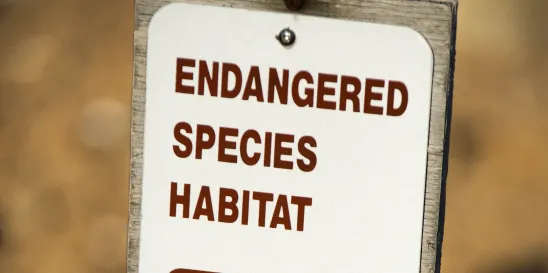On February 7, 2024, U.S. Environmental Protection Agency (EPA) Assistant Administrator Michal Freedhoff announced the steps EPA is taking to incorporate stakeholder feedback and collaborate with other federal agencies on its requirement to comply with the Endangered Species Act (ESA).
Under the Federal Insecticide, Fungicide, and Rodenticide Act (FIFRA), as part of the registration process, EPA must comply with ESA to ensure pesticides do not harm endangered species or their critical habitats. Complying with ESA has been challenging, resulting in multiple lawsuits against EPA for more than 20 years.
The Biden-Harris Administration’s efforts to address ESA issues include the following:
- In April 2022, EPA released its ESA Workplan, which establishes strategies and actions to adopt those protections while ensuring farmers, public health authorities, and others have access to pesticides.
- In November 2022, EPA issued an “ESA Workplan Update” that included more specific mitigation measures that are expected to be imposed to protect species.
- In June 2023, EPA proposed a Vulnerable Species Pilot (VSP) project.
- In June 2023, EPA announced draft mitigations for 27 species in an effort to protect species that are particularly vulnerable to pesticides.
- In July 2023, EPA announced its “Herbicide Strategy,” with its plans for ESA restrictions on herbicides as a class.
- In November 2023, EPA released an “Update on Vulnerable Species Pilot.”
EPA’s February 7, 2024, announcement includes the following:
Improved Species Maps
EPA announced that it will not implement the VSP protections for a species until a more refined map of its habitat is developed. This decision follows feedback EPA received that some of the maps included areas that endangered species do not live in, and that the areas in which pesticide mitigations would be required under the VSP were thus overly broad.
In addition, EPA announced that it is working with the U.S. Fish and Wildlife Service (FWS), the U.S. Department of Agriculture (USDA), the University of Georgia, and other stakeholders to develop maps that reflect better where these species actually live and where protections from pesticides are needed. EPA states it will plan to hold a workshop in April 2024 to facilitate and prioritize the development of these maps. EPA also states that it will develop guidelines that the public can use to develop and submit refined maps for hundreds of other endangered species.
Credit for Using Voluntary USDA Conservation Practices
In response to feedback on EPA’s July 2023 Draft Herbicide Strategy, EPA announced that on February 6, 2024, it signed a Memorandum of Understanding (MOU) with USDA, describing how EPA can include USDA’s Natural Resources Conservation Service (NRCS) conservation practices on pesticide labels as one way growers who voluntarily perform those practices can use them to help fulfill pesticide label requirements. EPA and USDA are planning meetings and workshops to discuss this MOU and seek input from producers regarding mitigation options that may count toward fulfilling pesticide label requirements. EPA states this approach is intended to provide more flexibility for growers on the type of practices they can use to protect endangered species and ensure EPA’s proposed mitigations can practically be implemented.
Online Mitigation Menu
As part of the changes EPA is making for ESA compliance, EPA announced it will launch its first online mitigation menu that will allow it to add new mitigation measures options quickly, which EPA states could allow growers to use those new options promptly. In 2024, EPA plans to release a draft online menu for public comment, and then update that menu based on feedback later in the year.
Offsets for Endangered Species Protections
EPA states it continues to work with stakeholders to determine how to use “offsets” when avoiding or minimizing pesticide exposure to an endangered species is impossible or impractical. In those situations, possible options to offset the impact to the species include funding habitat restoration for the species, contributing to a captive rearing project at a zoo for the species, or other steps to conserve the species. EPA announced it will participate in workshops later this month with other federal agencies and stakeholders to discuss how to bring offsets into EPA’s ESA-FIFRA work. EPA states its intent with this initiative is to provide pesticide registrants and users more flexibility to meet label requirements to protect endangered species, while directly contributing to recovering those species.
Commentary
These announced changes represent significant adjustments to the ESA program EPA has developed since issuing the April 2022 Workplan. Notably, delaying the VSP program until better habitat maps are available is a response to the significant critical comments received from many agricultural stakeholders. (And, the maps also were criticized as too broad by some environmental groups.) This is a central element of any successful species program, as more reliable maps are expected to reduce potential restrictions on pesticide users and provide more targeted protection to species.
Better coordination with USDA, especially with regard to more precise maps of use areas, along with more accurate habitat maps, is part of the continued refinements to EPA’s developing plans. These announcements address another point made in many stakeholder comments as EPA has outlined a “point” system that would require certain minimum points as part of its mitigation requirements, and the MOU regarding conservation practices can provide “points” for species protections if certain practices are followed. This approach will likely be applauded by grower groups who fear that in some cases, the options for “getting points” could otherwise leave no or few viable options for meeting EPA’s imposed mitigation plan for a particular crop or location.
Less noticed, but potentially impactful, is EPA’s statement about an online mitigation menu that will allow it to add new mitigation measures options quickly. This may prove controversial to the extent it removes or limits the typical back-and-forth between registrants and EPA. For decades, it has been common, if EPA determines additional label changes are called for as part of an EPA analysis, for registrants to respond to EPA concerns with rebuttal arguments or additional analysis and information responding to EPA concerns before any label changes are made. Electronic labels may provide the technology to change labels quickly, but the procedures to be followed to impose immediate label changes to an existing registration may present new legal issues.





 />i
/>i
